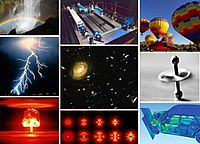
Photo from wikipedia
There is a substantial need to better understand multi-physics interactions in realistic laboratory experiments, yet it is currently unfeasible to perform direct numerical simulations (DNS) of most such problems. As… Click to show full abstract
There is a substantial need to better understand multi-physics interactions in realistic laboratory experiments, yet it is currently unfeasible to perform direct numerical simulations (DNS) of most such problems. As a result, reduced-order models such as those used to represent unclosed subgrid-scale stresses in large-eddy simulations (LES) and advanced numerical techniques, including adaptive mesh refinement and nested grid structures, are required for the study of multi-physics interactions in practical situations. In particular, it is now possible to model many real-world flows with LES fidelity, and to selectively refine the computational mesh in a small region of the domain to resolve multi-physics interactions with DNS fidelity. However, rules and guidance for the valid implementation of this multi-fidelity ‘hybrid LES-DNS’ approach have yet to be fully formulated. Within the embedded DNS region, multi-physics interactions will be influenced by (i) macroscale features (e.g. large-scale shear gradients or body forces that produce turbulence), (ii) LES-regulated mesoscale features (e.g. advecting turbulent eddies), and (iii) microscale features that are subgrid-scale to the LES (e.g. layers of fast-reacting intermediate chemical species). In this study, we address the second of these effects, which poses particular challenges due to the transfer and overlapping nature of advecting mesoscale eddies between the purely LES (i.e. macroscale) and purely DNS (i.e. microscale) regions. By combining dimensional analysis and computational results, we formulate a scaling law for the required depth of the transition zone surrounding the embedded DNS region within hybrid LES-DNS computations of realistic turbulent flows.
Journal Title: Journal of Turbulence
Year Published: 2020
Link to full text (if available)
Share on Social Media: Sign Up to like & get
recommendations!